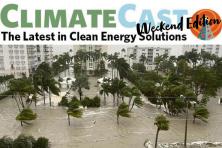At gatherings with friends or family, someone will often ask what I do for work.
Answering “I communicate on climate change!” is not quite what they expect, nor does it often feel like a conversation starter. Sometimes I add some dark humor to fill the silence.
At times, I feel awkward and quite a Debbie Downer whenever I try to talk about climate change. Do you?
It can feel hard to talk about climate even with those close to us, as it can seem politically charged and complicated.
Check out our climate conversation card to get tips for starting your own climate conversations. Bookmark it on your phone for quick reference!
So why should any of us talk about climate with more people we know and love? The Yale Program on Climate Change Communication found through its research that if people draw a personal connection to being impacted by global warming, they’re far more likely—double digits more—to take action to solve it. And through a poll we conducted with partners in Washington State in November 2018, we found that folks that talk about climate are far more likely to support solutions.
If we talk about how climate change affects our lives, it becomes a close-to-home problem rather one happening farther away or in the future. Yet according to the most recent data from Yale, most folks think the U.S. and the Pacific NW will be impacted—but don’t think global warming will impact them personally:


But who is best to try and talk with about the issue, and how do we avoid lowering a damper on a holiday weekend gathering?
First—never mind trying to convert cloimate deniers. It takes up too much energy, and arguably more time than we have available.
I’m most interested in the folks that are the largest slice of the “Six Americas”---the “concerned” folks that are sure we have a problem but not so sure we can solve it. Yale defines them as like the alarmed, “also convinced that global warming is happening and a serious problem, but have not yet engaged the issue personally.” Tthese are the folks we can move to act and possibly continue climate conversations beyond the holiday dinner table.

1. Take the temp with the weather. Weather is not climate—but it’s an easy topic to see where folks are at on the issue.
2. Acknowledge anxiety. We often avoid the topic because it’s scary and we feel powerless or don’t want to bring up what could feel like a depressing issue. Name that fear and the problem we face, and the other person will likely feel less anxious.
3. Connect personally. People are motivated to solve a problem if they feel personally affected by it. Connect with someone about local impacts we’re seeing, but don’t get stuck there! Solutions are the most important part of your story.
4. Talk about solutions, solutions, solutions. Wind and solar energy are highly popular, but people don’t necessarily see solutions happening. So talk up what you’re excited about, especially great things happening in our communities. Mention how there are industries standing in the way of progress.
5. Try and try again. The fossil fuel industry is invested in our cynicism—let’s invest in hope and determination instead. Some won’t want to talk about climate... but you’ll find that many others do. There’s nothing inevitable about the climate crisis—we can turn this around. Make your hope infectious!
Like these tips? Bookmark this link on your phone or laptop to create an easy resource. And let us know how it goes!
Sometimes I do get asked, “what can I do?” And after saying “vote!” my answer is now, “talk about it. A key step one in acknowledging we have a problem is to talk about it and we’re not even doing that very often.”
Will we solve a global problem one conversation at a time? No, we have lots of work to do in addition to accelerate clean energy solutions at a large scale fast enough to head off the worst of the climate impacts. Even as this problem continues to seem like such a wicked one to confront, we can show and learn together how having climate conversations can be easier—and necessary—and collective action can be too.





